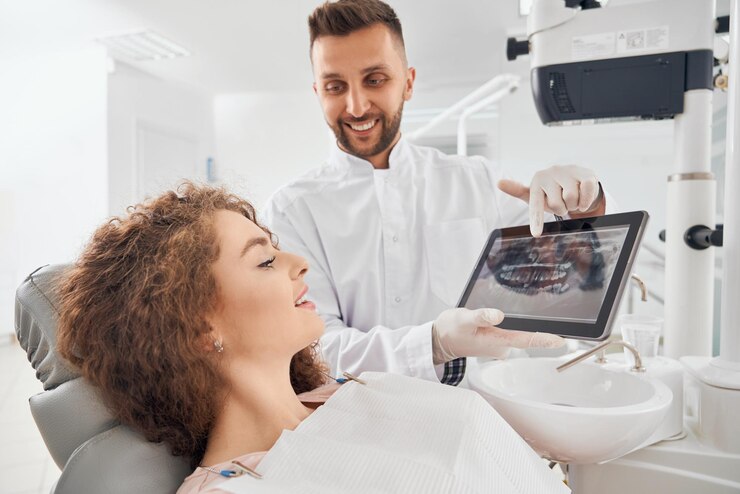The world of dentistry is witnessing a technological revolution where innovations are significantly improving patient experience, giving more accurate diagnoses, and increasing treatment efficiency. Among the most transformative developments in 2025 are digital impressions as well as augmented reality (AR). This is highly reshaping how dentists diagnose, plan, and also in executing treatments. One of the most exciting applications of such technologies is that of Digital Smile Design (DSD)-an entirely new paradigm that allows the patient to visualize his new smile before the treatment begins.
The Rise Of Digital Impressions
Moreover, the misery of having one’s mouth filled with messy putty is over. With digital impressions, intraoral scanners now record a sophisticated 3D image of the teeth and gums of a patient. Errors and the need for retakes are minimized with this high precision. What follows here are some major advantages of digital impressions-.
– A Level Higher Accuracy: Capturing fine details, digital scans enable restorations like crowns, veneers, and aligners to be accurate.
– Faster Turnaround Time: Unlike the traditional method which involves sending physical impressions to the lab for processing, data in digital format are transmitted for quicker treatment timelines.
– Improved Comfort To The Patient: Patients no longer have to endure several minutes of biting impression material to obtain impressions.
– Environment-Friendly Approach: It reduces material waste by totally removing physical molds. Thus, digital impressions are much better from the ecological perspective.
Augmented Reality-the Game Changer for Dentistry
Augmented reality (AR) is all set to revolutionize dentistry by improving patient education, treatment planning, and procedural guidance in real-time. AR involves superimposing digital images onto real-world views such that both dentists and laypersons could visualize treatment outcomes together while the procedure is going on.
Applications of AR in Dentistry
1. Patient Consultation & Treatment Visualization:
It also shows patients before undergoing a procedure like orthodontics, veneer placement, and dental implant, to hypothesize what they might end up looking like. With AR powered apps, patients can view Digital Smile Design simulations, which may give them relief with their treatment decisions.
2. Training Dentists & Dental Interns
AR training could enhance a dental student’s ability to become a proficient practitioner. Being able to simulate instead of dealing with actual human tissue would allow maximum practical training without any of the inherent dangers.
3. Guided Surgeries and Procedures
Real-time visual cues can also be provided by AR overlays to improve the accuracy of complex operations and thus reduce the chance of errors, especially in implant placements or in cases of root canal therapy for patients receiving treatment.
Digital Smile Design-The Future for Personalized Dentistry
The development of Digital Smile Design (DSD) marks a breakthrough for total personalized smile makeovers using digital impressions, AR, and AI technologies. This kind of active design enables dentists to craft smiles that match the patient’s facial features, personality, and aesthetic goals.
How DSD works:
1. Scanning & Imaging: Dentists take digital impressions with the intraoral scanner and photograph the patient as high-resolution pictures of the face and teeth.
2. Smile Simulation with AR: Patients then explore different smile designs on a screen using the AR software and make real-time adjustments according to their preferences.
3. Planning Customized Treatment: The final designs are then used to make precise treatment plans whether the patient is looking for veneers, orthodontics, or full mouth rehabilitation.
4.Trial Smiles: Some clinics now give temporary” trial smiles ” using mockups created through 3D printing so that patients can visually experience their new look before agreeing to it.
Benefits of Digital Smile Design
– Personalized Aesthetic: The new smile is tailored to the individual so that it blends with the shape and anatomy of the face.
– Increased Patient Confidence: Patients are very likely to accept a treatment procedure they are enthusiastic about after seeing the advancement in advance.
– Predictable Results: No guesswork at all; everything should meet the expectation at the end of the restoration.
– Improved Dentist Patient Communications: More involved participation of patients in the designing of their smiles.
This Could Mean for Patients in 2025
In 2025, patients experience high end, seamless technology from consultation to final restoration. The result is as follows: digital impressions, augmented reality, Digital Smile Design-ready:
– Shorter visits because diagnostics and the treatment plan are done much faster.
– Greater comfort as there are advances in minimally invasive techniques.
– Aesthetic and functional precision in every dental restoration.
– Confidence in their smile transformation before any procedure begins.
This exciting combination of digital impressions and augmented reality has radically changed dentistry in the year 2025. Digital Smile Design enhances it by giving patients a live preview of their coming smiles, reducing hazards that they may not be compatible with the treatments they’re going to receive. With the improvements in technology, dentistry is becoming even more precise, effective, and patient-centric than ever before.

